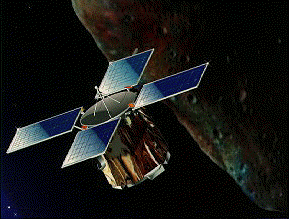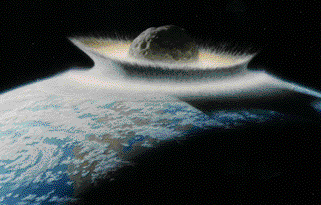All about asteroids
"A long time ago I heard a story that stars are the remains of a tribe of evil deities banished by the sun goddess."from "Murasaki", by Lisa Dalby
These words are spoken by a character in Lisa Dalby's historical novel about eleventh century Japan - a time and place when almost nothing was known about astronomy. It is hard for us now to imagine finding such a theory plausible. Even people who are not at all aware of the science behind astronomy will have mental pictures of the heavens which are firmly based on Newtonian mechanics. We believe that the planets are places we can travel to, and that the sun has the same nature as other stars.
Close Encounter

NEAR-Shoemaker, courtesy of NASA
Shooting stars
In times past, "shooting stars" were one of the most mysterious and frightening of celestial events, often regarded as signs and portents. A "shooting star" is a meteorite, almost all of which are rocks chipped off asteroids during collisions, and the way so much of this debris has managed to reach earth has long been a puzzle, inadequately modelled by computer simulations that only take gravitational effects into account.Now two scientists, David Vokrouhlicky, of Charles University in Prague, and the late Paolo Farinella, of the University of Trieste, have found a potential answer. The reason is that asteroids orbiting in the main asteroid belt - about 330 million to 480 million kilometres from the Sun - are heated unevenly by the Sun. This radiation is then re-emitted unevenly through the asteroid's day and year, resulting in a net force on the asteroid. According to recent computer simulations, over periods of 10 million to 100 million years this force, known as the Yarkovsky effect, can move smallish asteroids - of diameter less than about 20 km - into orbits in which they will be heavily affected by the gravity of one of the planets, and may be catapulted out of the main asteroid belt onto a potential collision course with Earth.
Asteroids everywhere

Two very different asteroids, courtesy of NASA
Recently, asteroids have been much in the news. We have been warned that previous estimates of the number of asteroids on a potential collision course with the Earth were too low - an underestimate of at least 20% , according to astronomers at the US-based Massachusetts Institute of Technology (MIT). Scott Stuart of MIT believes there are more than 1,100 objects within our Solar System that could come close to Earth. Since 1991, nine objects have come within two lunar distances of the Earth - about 800,000 km.
Astronomers use powerful telescopes to find and track asteroids by searching for objects that move against the background of fixed stars. The immense amount of data generated can be handled by powerful modern computers, and the trajectories of these objects extrapolated from this data. By observing an asteroid's path over several months, scientists can calculate its orbit and whether it might pose a threat to the Earth.

Painting of large asteroid impact by Donald E. Davis, courtesy of NASA
Asteroids bigger than one kilometre (0.6 miles) in diameter are thought to be capable of causing extensive damage on a global scale. No matter where such an asteroid hit the Earth, the substantial climate change "would lead to a rapid cut-off of the food supply and ultimately within a few months to a loss of probably a quarter of the world's population," said one expert. Such a major asteroid impact may have wiped out the dinosaurs.
The new estimate on the number of asteroids that could cause such damage is based on new calculations of the inclinations of asteroids - their angles of orbit in relation to the plane of the Earth's orbit around the Sun. Asteroids with low inclinations are the easiest to detect.
Such worries about potential catastrophic asteroid collisions naturally lead to the question - what can be done about it? The first step in dealing with any such event would be to predict it, and indeed experts in the UK recently called on the British Government to lead the way in creating an early warning system to defend the planet against potentially dangerous asteroids and comets.
At present, asteroids of smaller size - down to a few hundred metres across - are only detected by chance, in the course of other astronomical observations. The experts recommended that a new telescope - costing in the region of £15 million, should be built in the Southern Hemisphere, which is currently less well served than the Northern Hemisphere. The new telescope should be dedicated to searching for so-called Near Earth Objects (Neo's).